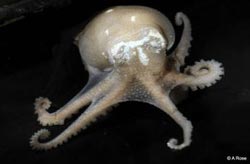Octopus' blue blood allows them to rule the waves!

The Antarctic octopod Pareledone charcoti photographed during the Polarstern cruise 2011 ANTXXVII/3. Credit: Armin Rose<br>
They manage to survive temperature habitats ranging from as low as -1.8°C to more than 30°C due to their ability to keep supplying oxygen to their body tissues. A new study, to be presented at the Society for Experimental Biology meeting on July 5, shows that a blue colored pigment, hemocyanin, in their blood, responsible for oxygen transport, crucially allows octopods to live in freezing temperatures.
Research by Michael Oellermann, Hans Pörtner and Felix Mark at the Alfred Wegener Institute for Polar and Marine Research in Germany, looked at how octopods are able to supply oxygen to tissues in freezing temperatures. The researchers compared the properties of blood pigment haemocyanin, responsible for oxygen transport, of Antarctic, Temperate and Warm-Adapted octopods.
The researchers found that the forms of haemocyanin of the Antarctic octopod Pareledone charcoti, are genetically and functionally different from the temperate and warmer climate octopods, facilitating oxygen release at sub-zero temperatures.
Michael Oellermann said: “Octopods are mainly local non-migratory species that move by crawling and have only short life stages in which they inhabit the water column. They are therefore mostly unable to migrate away from or escape “bad” environmental conditions, which exposes them to higher adaptive pressure to deal with these conditions. Our finding shows a crucial physiological adaption in cold environments that allows octopods to sustain an aerobic life.”
Media Contact
More Information:
http://www.sebiology.orgAll latest news from the category: Life Sciences and Chemistry
Articles and reports from the Life Sciences and chemistry area deal with applied and basic research into modern biology, chemistry and human medicine.
Valuable information can be found on a range of life sciences fields including bacteriology, biochemistry, bionics, bioinformatics, biophysics, biotechnology, genetics, geobotany, human biology, marine biology, microbiology, molecular biology, cellular biology, zoology, bioinorganic chemistry, microchemistry and environmental chemistry.
Newest articles

Machine learning algorithm reveals long-theorized glass phase in crystal
Scientists have found evidence of an elusive, glassy phase of matter that emerges when a crystal’s perfect internal pattern is disrupted. X-ray technology and machine learning converge to shed light…

Mapping plant functional diversity from space
HKU ecologists revolutionize ecosystem monitoring with novel field-satellite integration. An international team of researchers, led by Professor Jin WU from the School of Biological Sciences at The University of Hong…

Inverters with constant full load capability
…enable an increase in the performance of electric drives. Overheating components significantly limit the performance of drivetrains in electric vehicles. Inverters in particular are subject to a high thermal load,…





















